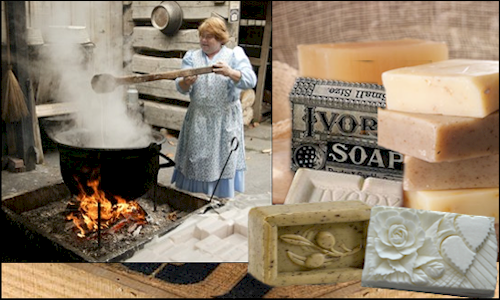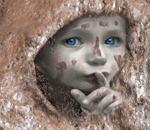Chapter 10
Chapter 10
Dirty Little Secrets of Soap
© Copyright 2009
by Dahni
Back in the 1800’s and even earlier, people made soap and mostly at home. Perhaps you have memory of this or your parents; grandparents remember ‘old fashioned’ lye soap? It took a while to make and it gave a pretty good ‘scrubbin.’ Some may recall it was a little tough on the skin, but maybe that’s was OK, as it made you tougher (mentally and physically). We have come a long way since then, even though this old fashioned soap is still made. Soap is still a part of our obsession with or our affinity with dirt, especially getting rid of dirt.

Soap made in the kettle would evolve to floating soap, soap carvings, synthetic soap and now there is a return to French milled soaps, designer soaps and even people making their own.
Soap has been a part of military provisions for a long time. Soldiers during the War Between the States often complained of ‘itch’ when they could not bathe and clean their uniforms, for lack of enough soap. We have already been down this dirt road before, as to the importance of regular bathing, personal hygiene and general health. But the two primary ingredients to soap making were wood ash and glycerin or tallow from animal renderings, animal fats.
I should stop right now and answer what you are probably wondering – what does soap have to do with ‘Dirty Little Secrets?’ Well, right here, it will show a reason for our continued obsession and affinity with dirt and the importance of pH. As this series finally concludes, you will get the whole picture of ‘Dirty Little Secrets,’ and it just all might make you healthy, wealthy and wise.
There used to be just handful of companies operating in the United States, making soap. A few of these were Lever Brothers, an English company, Proctor & Gamble, and Colgate which after a merger, became Colgate-Palmolive. Let us look at a little of their history.
Ivory Soap
A soap maker at the Procter and Gamble company had no idea a new innovation was about to surface when he went to lunch one day in 1879. He forgot to turn off the soap mixer, and more than the usual amount of air was shipped into the batch of pure white soap that the company sold under the name, ‘The White Soap.’ Fearing he would get in trouble, the soap maker kept the mistake a secret and packaged and shipped the air-filled soap to customers around the country. Soon customers were asking for more “soap that floats.” When company officials found out what happened, they turned it into one of the company’s most successful products, Ivory Soap. It was and remains a highly marketable idea, but most everyone knows that this so-called baby pure soap, melts. You are paying for a lot of air, which is what makes it float. Ivory soap probably is the brand that popularized ‘soap carving’ and the company still has contests held on occasion. There was a 12 foot ‘Statue of Liberty’ once carved out of Ivory Soap.
Lifebuoy
The English company, Lever Brothers, created Lifebuoy soap in 1895 and sold it as an antiseptic soap. They later changed its name to Lifebuoy Health Soap. Lever Brothers first coined the term “B.O.” for bad odor or body odor, as part of their marketing strategy for the soap.
Liquid Soap
William Shepphard first patented liquid soap on August 22, 1865. In 1980, the Minnetonka Corporation (yep the maker of moccasins), introduced the first modern liquid soap called ‘SOFT SOAP’ brand liquid soap. Minnetonka cornered the liquid soap market by buying up the entire supply of the plastic pumps needed for the liquid soap dispensers. In 1987, the Colgate Company acquired the liquid soap business from Minnetonka.
Palmolive Soap
William Colgate started a candle and soap making company in New York City in 1806. By 1906, the company was making over 3,000 different soaps, perfumes and other products. In 1864, Caleb Johnson founded a soap company called B.J. Johnson Soap Co., in Milwaukee, Wisconsin. In 1898, this company introduced a soap made of palm and olive oils, called Palmolive. It was so successful that the B.J. Johnson Soap Co. changed their name to Palmolive in 1917. Another soap making company, called the Peet Brothers Co. of Kansas City, Missouri started in 1872. In 1927, Palmolive merged with them and became Palmolive Peet. In 1928, Palmolive Peet merged with Colgate to form Colgate-Palmolive-Peet. In 1953, the name was shortened to just Colgate-Palmolive. Ajax cleanser was one of their first major brand names introduced in the early 1940s.
Fast Forward to the 40’s
In the 40’s, the USA as well as most of the world, were involved with the Second World War. In Germany, glycerin, normally used in making soap was in short supply to support the war efforts. Soldiers came first and munitions, before the German people. The people were upset because they could not make enough soap and glycerin was being used to make explosives, like nitroglycerin and dynamite. German scientists came up with a formula for making ‘synthetic soap by primarily using simple sodium and another ingredient. American soap companies could not wait to get their hands on these formulas, which after the war, they did. The new synthetic soap was way cheaper to make, but instead of passing these huge cost savings on to their customers, they charged more. A new era of profits in soap and related products had begun.
There was just one problem with this ‘new soap,’ it did not smell very good. Why, because the new ingredient instead of glycerin was petroleum. Petroleum, yep, oil. Some NY advertising executive came up with the idea of adding fragrance to the new soap. Soon there was a plethora of new slogans to promote their products from soap, deodorant soaps, deodorant, laundry detergents, and fabric softeners, among others. In no time at all, the public would associate what is clean, fresh and dry with such familiar phrases as: ‘that April Fresh Smell’ and ‘Never let them see you sweat.’ Clean, dry and fresh became synonymous with fragrance. If something did not have the right smell, it must be dirty.
What exactly does clean smell like? It would be like trying to describe the taste of a banana. A banana just tastes like a banana and clean just smells clean. The dirty little secret to this whole advertising blitz was to cover up something that stunk (petroleum, oil), in order to sell a cheaper product to make, at a higher price to the public!
Side note:
The use of fragrance (perfumes, colognes etc.), were not new. Kings, Queens, and the wealthy used fragrance to cover their body odor. Even those of privilege and wealth found regular bathing to be time consuming and impractical.
What else could advertisers, marketers and product makers do to increase their profits? Besides convincing the public that clean had to smell a certain way, how could they get us to buy more and more of their products? Thus begun the age of the mass consumption of consumables!
To increase their profits, they began to design almost everything with ‘built-in obsolescence. Laundry detergents started to cause fabrics to wear out faster. Soap would melt. Soap scum made us need something to clean that. Deodorants in sprays contained more propellant than active ingredients. This would later lead to the familiar term seen in everything from a box of soap flakes to a box of cereal, ‘Sold by weight and not by volume,’ or ‘Some settling may occur.” Flakes and powered soaps evolved and became liquid and then we began to see the term ‘Ultra’ on everything, thinking it was a better product. Basically, these ‘Ultra’ products removed the water so the costs were less, but we paid more for them and provided our own water. Clothing washed was stiff and began to grey or get the ‘dingy-ies’ Soon special stuff was added in your detergents, just to protect your equipment instead of just washing your clothes. Water softeners were added and called, ‘fabric softeners.’ Optical brighteners were added and first called ‘blueing agents.’ To this day, most liquid fabric sotners are the blue in color. There is a reason. Blue refracts light very well. So if it is not clean, make it look clean and make it shiny. Same kind of stuff is used in many hair shampoos. Have you ever heard of ‘Selsun Blue.’ It is a dandruff shampoo. By the way, most dandruff shampoos use similar ingredients. Those ingredients unbuffered or in its undiluted state can literally melt or disolve metal. So do they really help remove the cuase of dandruff, or just mildly burn the scalp, err ‘scuse’ me, burn off the dead flakes?
Almost everything seemed to wear out or run out, faster and faster. Surely you do not believe it was not pre-designed or pre-engineered not to? Even cars started to wear out faster. Instead of using all this knowledge, science and technology to produce quality products, the focus was to minimize costs and maximize the profits at the expense of the public. It was once explained to me that the technology, science and knowledge applied to landing people on the moon and to get them safely back to earth, approximately 99.9999999% of all systems had to be working perfectly.
Translating this to the automobile industry, we would all be driving the same car a lifetime or one that would last a 100 years.
I have no problem with business making a profit, but there has to be a balance between affordability and quality.
The dirty little secret of all these cleaning products centers on the word ‘clean.’ To clean something, there must be at least a fundamental understanding and application of pH and more specifically, pH balancing.
WOW, this stuff is really getting dirty! We are not done. There is much more to come and more ‘Dirty Little Secrets‘ to share next time.

Dirty Dahni